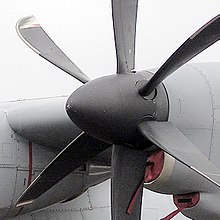Variable-pitch propeller (marine)
A controllable pitch propeller (CPP) or variable pitch propeller is a special type of propeller with blades that can be rotated around their long axis to change their pitch. If the pitch can be set to negative values, the reversible propeller can also create reverse thrust for braking or going backwards without the need of changing the direction of shaft revolutions.
Aircraft

Such propellers are used in propeller aircraft to adapt the propeller to different thrust levels and air speeds so that the propeller blades don't stall, hence deteriorating the propulsion system's efficiency. Especially for cruising, the engine can operate in its most economical range of rotational speeds. With the exception of going into reverse for braking after touch-down, the pitch is usually controlled automatically without the pilot's intervention. A propeller with a controller that adjusts the blades' pitch so that the rotational speed always keeps the same is called a constant speed propeller.
The most common type of controllable pitch propeller is hydraulically actuated; it was originally developed by Frank W. Caldwell of the Hamilton Standard Division of the United Aircraft Company. This design led to the award of the Collier Trophy of 1933 [1] .
Ships

Controllable pitch propellers (CPP) for marine propulsion systems have been designed to give the highest propulsive efficiency for any speed and load condition. When the vessel is fully loaded with cargo the propulsion required is much higher than when the vessel is empty. By adjusting the blade pitch, the optimum efficiency can be obtained and fuel can be saved. Also, the controllable pitch propeller also has a "vane"-stance, which is useful with combined sailing/motorvessels as this stance gives the least waterresistance when not using the propeller (eg when the sails are used instead).
While it is true that a fixed pitch propeller (FPP) can be more efficient than a controllable pitch propeller, it can only be so at one rotational speed and the designed load condition. At that one rotational speed and load, it is able to absorb all the power that the engine can produce. At any other rotational speed, or any other vessel loading, the FPP cannot, either being over pitched or under pitched. A correctly sized controllable pitch propeller can be efficient for a wide range of rotational speeds, since pitch can be adjusted to absorb all the power that the engine is capable of producing at nearly any rotational speed.
The CPP also improves maneuverability of a vessel. When maneuvering the vessel the advantage of the CPP is the fast change of propulsion direction. The direction of thrust can be changed without slowing down the propeller and depending on the size of the CPP can be changed in approximately 15 to 40 seconds. The increased maneuverability can eliminate the need for docking tugs while berthing.
A reversing gear or a reversible engine is not necessary anymore, saving money to install and service these components. Depending on the main engine rotational speed and the size of the CPP, a reduction gear may still be required. A CPP does require a hydraulic system to control the position of the blades. A CPP does not produce more or less wear or stress on the propeller shaft or propulsion engine than an FPP. Therefore this will not be an argument to choose between an FPP or a CPP.
Most ships that wouldn't take a CPP are large vessels that make long trips at a constant service speed, for example crude oil tankers or the largest container ships which have so much power that a CPP is not yet designed for them. A CPP can mostly be found on harbor or ocean-going tugs, dredgers, cruise ships, ferries and cargo vessels that sail to ports with limited or no tug assistance.
At the moment the range of CPP goes up to 44000 kW (60,000 hp).
